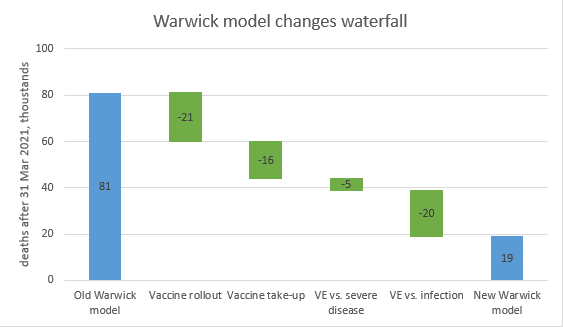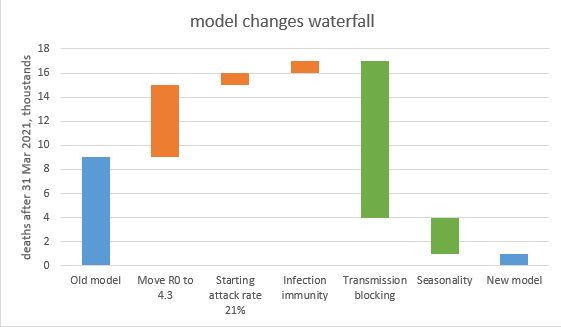
Reflecting on this week’s “lockdown vs. vaccines” debate, while the binary logic of “it's one or the other – which is it?” is clearly wrong, my initial reaction of “it’s a bit of both, the balance changes over time” was also slightly too reductive. 1/
https://twitter.com/JamesWard73/status/1381948630895095810?s=20
Surely the bigger strategic point is this: to get to the relatively good place we’re in now, we needed both lockdown AND vaccines. Essentially, lockdown kept the virus pinned down until the vaccines were ready to come and knock it on the head. 2/
This wouldn’t be a proper thread without some numbers from the model to illustrate it, so here goes. First, let’s start with a world where there is no lockdown, and no vaccine. The tricky bit here is what to do instead of lockdown: I think the most realistic alternative… 3/
…would be the maintenance of baseline controls (e.g. TTI / masks), but no other legal restrictions. But I’ve inserted a strong voluntary behavioural response into the model, which means that people reduce their own risks when they see high levels of hospital admissions. 4/
With that assumption, we tend to get oscillating waves, of gradually reducing size, until the epidemic is complete. The strength of the behavioural response drives the number and size of the waves, but doesn’t change the eventual outcome much – around 280k people would die. 5/ 

Now, let’s see what happens if we replace the voluntary response with a compulsory lockdown, which is released along the lines of the current roadmap. Unsurprisingly, it just pushes the problem a bit further down the road – still, around 280k people die, just a bit later. 6/ 

Alternatively, instead of the lockdown, we introduce a vaccine rollout (at the same speed as we are getting). Here we see a bigger benefit: deaths are reduced to ~160k, and the later waves are eliminated. But vaccines were just too late to stop that awful initial wave. 7/ 

Finally, if we have both the lockdown and the vaccines, we get the (relatively positive) situation we find ourselves in today, with only ~30k deaths projected from 2021 infections, the vast majority of which have already happened. 8/ 

I would emphasise that the numbers of deaths, and the exact timing of waves etc. are sensitive to lots of assumptions, and are not meant to be taken too literally. What’s important here is the strategic “shape” and its interpretation. And the message here is clear: 9/
We needed the lockdown to stop the B.1.1.7 driven wave in Dec/Jan 2021, because the vaccines weren’t ready to roll out in volume. Only the teamwork of lockdown and vaccine was able to do the job: one to slow the virus’s spread, and the other to finish it off. 10/
And that’s it. The justification for the lockdown – and particularly this recent one – was always that it bought us time for the vaccines to be rolled out. And that hasn’t changed, we just seem to keep forgetting the logic that got us here. 11/
PS thanks to @DevanSinha for prompting and challenging my thinking on this /end
• • •
Missing some Tweet in this thread? You can try to
force a refresh











